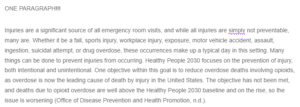Peer Response-ER Nurse in Addressing the Opioid Overdose and Addiction Crisis
Hello Caitlin,
This is a very informative post. Your unwavering commitment as an ER nurse in addressing the opioid overdose and addiction crisis cannot go unnoticed. Your dedication to providing patients and their families with critical information and resources is commendable. It is important to recognize that addiction concerns can surface unexpectedly in the ER, emphasizing the need for readily available resources encompassing treatment options, support groups, and Narcan programs (Kaye et al., 2020). I actively advocate for addiction awareness and ensure educational materials are accessible when required. However, it’s crucial to acknowledge the broader context of the opioid crisis and the pharmaceutical industry’s role in it. To effectively combat this crisis, I recommend advocating for stricter regulations on pharmaceutical marketing practices, supporting prescription monitoring programs, promoting awareness campaigns, and improving accessibility to addiction treatment programs (Haegerich et al., 2019). These proactive measures, combined with your dedication, can significantly contribute to addressing the opioid crisis comprehensively, ensuring that even when addiction isn’t the primary concern, patients receive the necessary support.
Reference
Haegerich, T. M., Jones, C. M., Cote, P., Robinson, A., & Ross, L. (2019). Evidence for state, community and systems-level prevention strategies to address the opioid crisis. Drug and Alcohol Dependence, 204, 107563. https://doi.org/10.1016/j.drugalcdep.2019.107563
Kaye, A. D., Granier, A. L., Garcia, A., Carlson, S. F., Fuller, M. C., Haroldson, A. R., White, S., Krueger, O. L., Novitch, M. B., & Cornett, E. M. (2020). Non-Opioid Perioperative Pain Strategies for the Clinician: A Narrative Review. Pain and Therapy, 9(1), 25–39. https://doi.org/10.1007/s40122-019-00146-3
ORDER A PLAGIARISM-FREE PAPER HERE
We’ll write everything from scratch
Question
Module 2 Discussion Topic 1 REPLY TO CATILIN POST
ONE PARAGRAPH!!!
Injuries are a significant source of all emergency room visits, and while all injuries are simply not preventable, many are. Whether it be a fall, sports injury, workplace injury, exposure, motor vehicle accident, assault, ingestion, suicidal attempt, or drug overdose, these occurrences make up a typical day in this setting. Many things can be done to prevent injuries from occurring. Healthy People 2030 focuses on the prevention of injury, both intentional and unintentional. One objective within this goal is to reduce overdose deaths involving opioids, as overdose is now the leading cause of death by injury in the United States. The objective has not been met, and deaths due to opioid overdose are well above the Healthy People 2030 baseline and on the rise, so the issue is worsening (Office of Disease Prevention and Health Promotion, n.d.).

Peer Response-ER Nurse in Addressing the Opioid Overdose and Addiction Crisis
As an ER nurse, I have seen my fair share of drug overdoses, and many of these cases involve opioids. Overdoses are often unintentional and occur when someone takes too much of the medication or drug or by accidental ingestion. Accidental ingestion is frequently seen in children, and a recent study found that opioids accounted for over 52% of accidental poisonings of children aged 5 and under in the year 2018, a number that had doubled since 2005 (Gaw et al., 2023).
Alabama is the state I live and work in, and it has been noted to have the highest per capita opioid prescription rate in the nation. While these rates have gone down since attention was first drawn to this in 2012, Alabama was still the highest in the nation, with a rate of 121 opioid prescriptions per 100 persons in 2016 (Alabama Department of Mental Health, n.d.). This is relevant to my job as an ER nurse not only because opioid medication is prescribed in our setting but because national attention was brought to this because these medications were being overprescribed. While narcotic pain medication is something I use daily on shift, it can lead to addiction and must be regulated. Educating patients on opioid use, abuse, side effects, and safe storage is integral in the prevention of overdose and death, in addition to finding alternatives to opioid medications for pain relief.
Patients come to the ER for various reasons, and while someone may not come in for overdose or addiction issues, addiction may be an underlying problem discovered during the visit. It is important that we do not ignore this and provide appropriate resources and education when indicated. Resources on treatment facilities, medication-assisted treatment programs, support groups, the free Narcan program, and where to get Narcan should be readily available and openly discussed with patients and their loved ones. Also, education on Narcan use is essential, as one dose of Narcan may not be enough, and the effects of the opioid may persist after the Narcan wears off.
I have personally advocated for drug and alcohol addiction awareness and resources in the ER I work in. I have helped to acquire and organize pre-printed information readily available for nurses to give to patients and their loved ones, and I do not hold back if I think a patient may be suffering from addiction. I bring up my concerns in a nonjudgmental manner, I lend an ear, and pass along the appropriate resources and advocate for necessary referrals.


